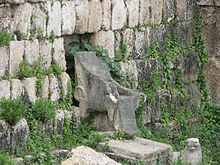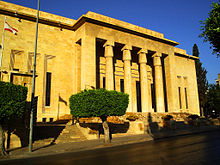Portal:Phoenicia
THE PHOENICIA PORTAL

Phoenicia (/fəˈnɪʃə, fəˈniːʃə/), or Phœnicia, was an ancient Semitic thalassocratic civilization originating in the coastal strip of the Levant region of the eastern Mediterranean, primarily located in modern Lebanon. The territory of the Phoenicians expanded and contracted throughout history, with the core of their culture stretching from Arwad in modern Syria to Mount Carmel in modern Israel. Beyond their homeland, the Phoenicians extended through trade and colonization throughout the Mediterranean, from Cyprus to the Iberian Peninsula.
The Phoenicians directly succeeded the Bronze Age Canaanites, continuing their cultural traditions following the decline of most major cultures in the Late Bronze Age collapse and into the Iron Age without interruption. It is believed that they self-identified as Canaanites and referred to their land as Canaan, indicating a continuous cultural and geographical association. The name Phoenicia is an ancient Greek exonym that did not correspond precisely to a cohesive culture or society as it would have been understood natively. Therefore, the division between Canaanites and Phoenicians around 1200 BC is regarded as a modern and artificial division.
The Phoenicians, known for their prowess in trade, seafaring and navigation, dominated commerce across classical antiquity and developed an expansive maritime trade network lasting over a millennium. This network facilitated cultural exchanges among major cradles of civilization, such as Greece, Egypt, and Mesopotamia. The Phoenicians established colonies and trading posts across the Mediterranean; Carthage, a settlement in northwest Africa, became a major civilization in its own right in the seventh century BC.
The Phoenicians were organized in city-states, similar to those of ancient Greece, of which the most notable were Tyre, Sidon, and Byblos. Each city-state was politically independent, and there is no evidence the Phoenicians viewed themselves as a single nationality. While most city-states were governed by some form of kingship, merchant families probably exercised influence through oligarchies. After reaching its zenith in the ninth century BC, the Phoenician civilization in the eastern Mediterranean gradually declined due to external influences and conquests. Yet, their presence persisted in the central and western Mediterranean until the destruction of Carthage in the mid-second century BC. — Read more about Phoenicia, its mythology and language
 Featured article
•
Featured article
•
A Featured article represents some of the best content on Wikipedia
The Battle of Bagradas, the Bagradas, or the Bagradas River (the ancient name of the Medjerda) may refer to:
- Battle of the Bagradas River (255 BC), also known as the Battle of Tunis, during the First Punic War
- Battle of the Bagradas River (240 BC), also known as the Battle of the Macar, during the Mercenary War
- Battle of the Bagradas River (203 BC), usually known as the Battle of the Great Plains, during the Second Punic War
- Battle of the Bagradas River (49 BC), a battle during the Roman civil war between Caesar and Pompey
- Battle of the Bagradas River (536), a battle between the rebel leader Stotzas and Byzantine commander Belisarius (Full article...)
List of Featured articles
|
|---|
Phoenician mythology •
Images
 Good article
•
Good article
•
A Good article meets a core set of high editorial standards
The National Museum of Beirut (Arabic: متحف بيروت الوطنيّ, Matḥaf Bayrūt al-waṭanī) is the principal museum of archaeology in Lebanon. The collection begun after World War I, and the museum was officially opened in 1942. The museum has collections totaling about 100,000 objects, most of which are antiquities and medieval finds from excavations undertaken by the Directorate General of Antiquities.
During the 1975 Lebanese Civil War, the museum stood on the front line that separated the warring factions. The museum's Egyptian Revival building and its collection suffered extensive damage in the war, but most of the artifacts were saved by last-minute preemptive measures. (Full article...)Phoenician inscriptions & language •
The Corpus Inscriptionum Semiticarum ("Corpus of Semitic Inscriptions", abbreviated CIS) is a collection of ancient inscriptions in Semitic languages produced since the end of 2nd millennium BC until the rise of Islam. It was published in Latin. In a note recovered after his death, Ernest Renan stated that: "Of all I have done, it is the Corpus I like the most."
The first part was published in 1881, fourteen years after the beginning of the project. Renan justified the fourteen year delay in the preface to the volume, pointing to the calamity of the Franco-Prussian war and the difficulties that arose in the printing the Phoenician characters, whose first engraving was proven incorrect in light of the inscriptions discovered subsequently. A smaller collection – Répertoire d'Épigraphie Sémitique ("Repertory of Semitic Epigraphy", abbreviated RES) – was subsequently created to present the Semitic inscriptions without delay and in a deliberately concise way as they became known, and was published in French rather than Latin. The Répertoire was for the Corpus Inscriptionum Semiticarum what the Ephemeris epigraphica latina was for the Corpus Inscriptionum Latinarum.
The publication of the series continued until 1962. (Full article...)Did you know (auto-generated) •

- ... that alongside a 7th-century BC Phoenician shipwreck, two additional wrecks from various historical periods were unearthed in Bajo de la Campana, situated off the coast of Cartagena, Spain?
- ... that Bochart's 1646 Geographia Sacra seu Phaleg et Canaan was the first full-length book devoted to the Phoenicians?
- ... that Eshmunazar I, the Phoenician king of Sidon, participated in the Neo-Babylonian campaigns against Egypt, where he seized stone sarcophagi belonging to members of the Egyptian elite?
- ... that the discovery of Phoenician metal bowls in 1849 created the entire concept of Phoenician art?
- ... that the earliest-known Phoenician inscriptions were found near Bethlehem?
- ... that the deity of the Phoenician sanctuary of Kharayeb remains unidentified due to the absence of names of specific gods in unearthed inscriptions?
Related portals
Categories
Wikiproject
Other Wikimedia and Wikiportals
The following Wikimedia Foundation sister projects provide more on this subject:
-
Commons
Free media repository -
Wikibooks
Free textbooks and manuals -
Wikidata
Free knowledge base -
Wikinews
Free-content news -
Wikiquote
Collection of quotations -
Wikisource
Free-content library -
Wikiversity
Free learning tools -
Wikivoyage
Free travel guide -
Wiktionary
Dictionary and thesaurus
Parent portal: Lebanon














































